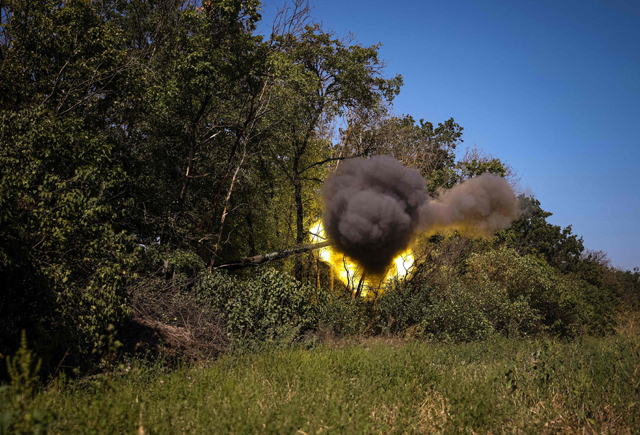MYKOLAIV, Ukraine — Intense fighting was raging on Tuesday across the southern Ukrainian region of Kherson occupied by Russia, Kyiv's presidency said, as its troops pressed counter-offensives "in various directions".
Most of region of Kherson bordering the Black Sea, and its provincial capital of the same name, were seized by Moscow's military at the start of the invasion six months ago.
With the war in the eastern Donbas region largely stalled, analysts have said for weeks that combat is likely to shift south to break the stalemate before winter comes.
Also on Tuesday, fresh Russian strikes in the northeast city of Kharkiv killed at least five people, prompting officials to urge people to stay indoors.
But much of the attention remained on the counter-offensive in the south.
In its morning update the president's office in Kyiv said "heavy fighting is taking place in almost the entire territory of the Kherson region".
"Powerful explosions continued throughout the day and throughout the night" and "the Armed Forces of Ukraine launched offensive actions in various directions," it added.
In his nightly address on Monday, President Volodymyr Zelensky was coy about Ukraine's overarching strategy whilst striking a bullish tone.
"You won't hear the specifics from any person in charge because this is war."
"But the occupiers should know that we will push them to our borderline," he added.
"If they want to survive, it is time for the Russian military to flee. Go home."
'Stay inside'
Britain's defence ministry said starting early Monday "several brigades of the Ukrainian armed forces increased the weight of artillery fires in front line sectors across southern Ukraine".
It warned that since the start of August, Russia has made "significant efforts" to reinforce troops on the western bank of the Dnipro River which splits Kherson city.
But the Ukrainian presidency claimed its forces had destroyed "almost all large bridges" and that "only pedestrian crossings remain" in Kherson region.
The British ministry said “most of the units around Kherson are likely under-manned and are reliant upon fragile supply lines by ferry and pontoon bridges across the Dnipro”.
“It is not yet possible to confirm the extent of Ukrainian advances,” the ministry added on Tuesday.
In Ukraine’s second city Kharkiv, at least five people were killed on Tuesday as Russian shelling hit the centre of town, the mayor Igor Terekhov said.
Seven people were also wounded, and regional governor, Oleg Synegubov, gave a slightly lower death toll of four and said another four were injured.
“The Russian occupiers shelled the central districts of Kharkiv,” Synegubov said on Telegram, as he warned residents to “stay inside the shelters”.
Grain reaches Djibouti
The war has contributed to a global food and energy price crisis.
Russia blockaded Ukraine’s ports on the Black Sea at the start of the war, choking off the major harvest exporter from world markets and punishing poorer nations.
On Tuesday, the first UN-chartered vessel transporting grain to relieve the food crisis made port in Djibouti, after Turkey and the UN brokered a deal to relax the embargo last month.
Some 23,000 tonnes of wheat aboard the MV Brave Commander is bound for Ethiopia, where millions are at risk of starvation.
Meanwhile German chancellor Olaf Scholz said the nation — which along with the EU bloc has pledged to wean itself off Russian gas — is well prepared for curbs on supply.
Germany is set to meet an October target to replenish stocks early, Scholz said on Tuesday, a day before Moscow is due to cut off gas supplies for three days.
He said Germany is “in a much better position in terms of security of supply than was foreseeable a couple of months ago”.
Challenging offensive
Moscow’s troops seized Kherson, a town of 280,000 inhabitants, on March 3. It was the first major city to fall following Moscow’s invasion of Ukraine on February 24.
In an update early on Tuesday, Ukraine’s Southern Command said the situation remained “tense” in its area of operations.
“The enemy attacked our positions five times, but was unsuccessful,” it said.
The city of Mykolaiv, just northwest of Kherson, had come under “massive bombardment” from Russian anti-aircraft missiles, with two civilians killed and 24 wounded, it said.
On Monday, Russia’s defence ministry claimed it had repulsed attacks in the Kherson and Mykolaiv regions and inflicted “heavy losses” on Ukrainian forces.
The ministry said Ukraine’s troops attempted attacks in “three directions” but that they lost more than 560 servicemen and 26 tanks.
But a senior Pentagon official said Russia was struggling to find soldiers to fight in Ukraine and that many new recruits were older, in poor shape and lacking training.
The fresh fighting came as students across Ukraine prepared to return to classrooms on Thursday after schools were shut by the Russian invasion, now in its seventh month.
Only those schools with air raid bunkers will be permitted to reopen, with the rest reverting to online learning.
“We just want to live our life fully,” 16-year-old student Polina told AFP in Kyiv
“We are not afraid, we have already lived enough. Our generation has decided to live in the present moment.”
